What Is The Name Of The Hybrid Orbitals Used By Phosphorus In Pcl3?
Chapter eight. Avant-garde Theories of Covalent Bonding
viii.ii Hybrid Atomic Orbitals
Learning Objectives
By the end of this section, you will be able to:
- Explain the concept of diminutive orbital hybridization
- Decide the hybrid orbitals associated with diverse molecular geometries
Thinking in terms of overlapping diminutive orbitals is one manner for us to explain how chemical bonds form in diatomic molecules. However, to understand how molecules with more than than two atoms form stable bonds, we crave a more detailed model. As an example, let us consider the water molecule, in which we have one oxygen cantlet bonding to ii hydrogen atoms. Oxygen has the electron configuration 1south iiiis 2iip four, with two unpaired electrons (i in each of the two iip orbitals). Valence bond theory would predict that the 2 O–H bonds form from the overlap of these two 2p orbitals with the isouthward orbitals of the hydrogen atoms. If this were the case, the bond angle would be xc°, equally shown in Figure ane, because p orbitals are perpendicular to each other. Experimental evidence shows that the bond angle is 104.v°, not ninety°. The prediction of the valence bail theory model does not match the real-world observations of a water molecule; a different model is needed.
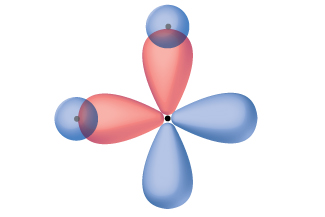
Breakthrough-mechanical calculations suggest why the observed bail angles in H2O differ from those predicted by the overlap of the 1south orbital of the hydrogen atoms with the twop orbitals of the oxygen atom. The mathematical expression known every bit the wave role, ψ, contains information about each orbital and the wavelike properties of electrons in an isolated atom. When atoms are bound together in a molecule, the moving ridge functions combine to produce new mathematical descriptions that accept different shapes. This process of combining the wave functions for atomic orbitals is called hybridization and is mathematically accomplished by the linear combination of atomic orbitals, LCAO, (a technique that we volition run across again subsequently). The new orbitals that result are called hybrid orbitals. The valence orbitals in an isolated oxygen cantlet are a twos orbital and three 2p orbitals. The valence orbitals in an oxygen cantlet in a water molecule differ; they consist of 4 equivalent hybrid orbitals that point approximately toward the corners of a tetrahedron (Figure two). Consequently, the overlap of the O and H orbitals should issue in a tetrahedral bail angle (109.5°). The observed angle of 104.5° is experimental evidence for which quantum-mechanical calculations requite a useful explanation: Valence bond theory must include a hybridization component to give accurate predictions.
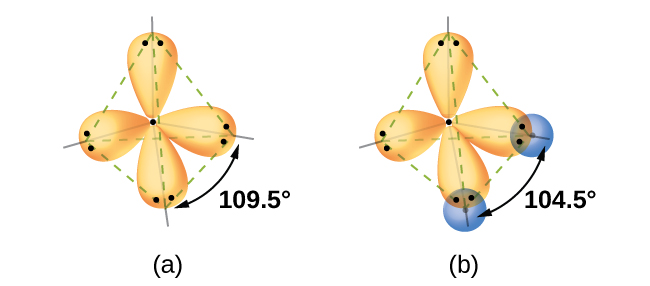
The following ideas are important in understanding hybridization:
- Hybrid orbitals do not exist in isolated atoms. They are formed only in covalently bonded atoms.
- Hybrid orbitals have shapes and orientations that are very different from those of the atomic orbitals in isolated atoms.
- A gear up of hybrid orbitals is generated by combining atomic orbitals. The number of hybrid orbitals in a prepare is equal to the number of atomic orbitals that were combined to produce the ready.
- All orbitals in a set up of hybrid orbitals are equivalent in shape and free energy.
- The type of hybrid orbitals formed in a bonded atom depends on its electron-pair geometry as predicted by the VSEPR theory.
- Hybrid orbitals overlap to grade σ bonds. Unhybridized orbitals overlap to form π bonds.
In the post-obit sections, we shall discuss the common types of hybrid orbitals.
sp Hybridization
The glucinium atom in a gaseous BeCl2 molecule is an example of a key atom with no lone pairs of electrons in a linear organization of three atoms. There are two regions of valence electron density in the BeCl2 molecule that stand for to the 2 covalent Exist–Cl bonds. To accommodate these two electron domains, two of the Exist atom's four valence orbitals volition mix to yield two hybrid orbitals. This hybridization procedure involves mixing of the valence s orbital with 1 of the valence p orbitals to yield two equivalent sp hybrid orbitals that are oriented in a linear geometry (Figure 3). In this figure, the set of sp orbitals appears like in shape to the original p orbital, just there is an important difference. The number of diminutive orbitals combined always equals the number of hybrid orbitals formed. The p orbital is one orbital that tin can hold up to 2 electrons. The sp ready is 2 equivalent orbitals that indicate 180° from each other. The ii electrons that were originally in the s orbital are now distributed to the two sp orbitals, which are half filled. In gaseous BeCl2, these half-filled hybrid orbitals will overlap with orbitals from the chlorine atoms to form two identical σ bonds.
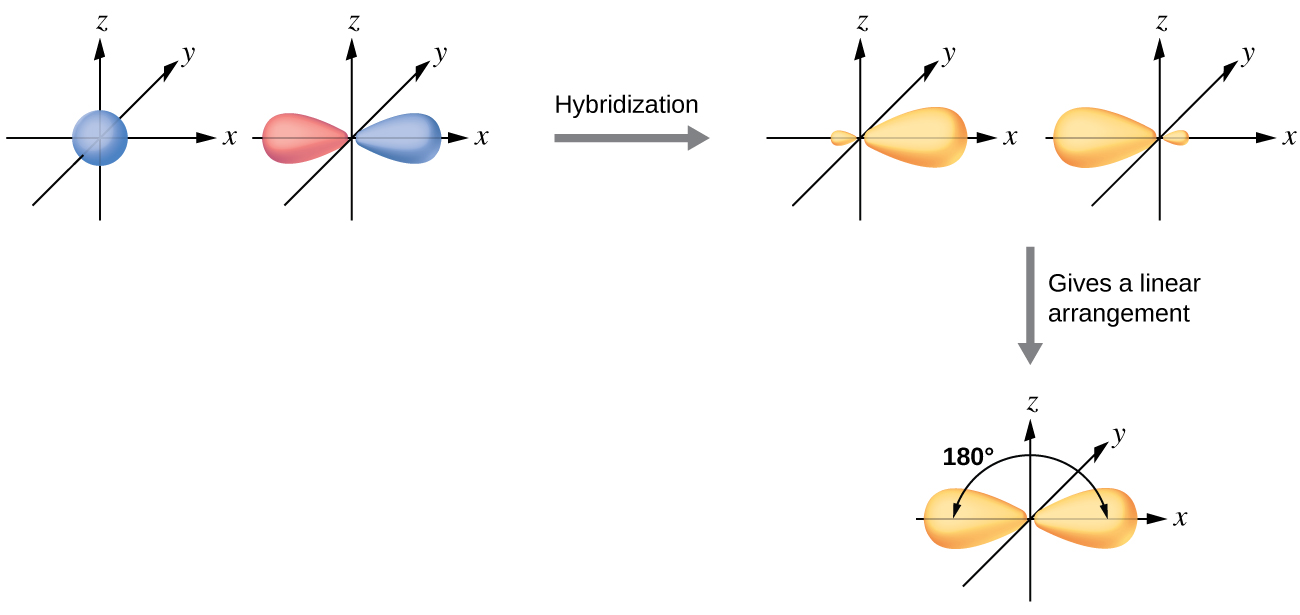
We illustrate the electronic differences in an isolated Be cantlet and in the bonded Be atom in the orbital energy-level diagram in Figure 4. These diagrams correspond each orbital by a horizontal line (indicating its energy) and each electron past an arrow. Energy increases toward the height of the diagram. We utilize one upward pointer to signal one electron in an orbital and 2 arrows (up and down) to indicate 2 electrons of opposite spin.

When diminutive orbitals hybridize, the valence electrons occupy the newly created orbitals. The Be atom had two valence electrons, so each of the sp orbitals gets one of these electrons. Each of these electrons pairs up with the unpaired electron on a chlorine atom when a hybrid orbital and a chlorine orbital overlap during the formation of the Be–Cl bonds.
Any central cantlet surrounded by only two regions of valence electron density in a molecule volition exhibit sp hybridization. Other examples include the mercury cantlet in the linear HgCl2 molecule, the zinc cantlet in Zn(CHthree)2, which contains a linear C–Zn–C arrangement, and the carbon atoms in HCCH and CO2.

Check out the University of Wisconsin-Oshkosh website to larn about visualizing hybrid orbitals in iii dimensions.
sp 2 Hybridization
The valence orbitals of a primal atom surrounded past 3 regions of electron density consist of a set of three sp ii hybrid orbitals and ane unhybridized p orbital. This system results from sp two hybridization, the mixing of one s orbital and two p orbitals to produce three identical hybrid orbitals oriented in a trigonal planar geometry (Figure v).
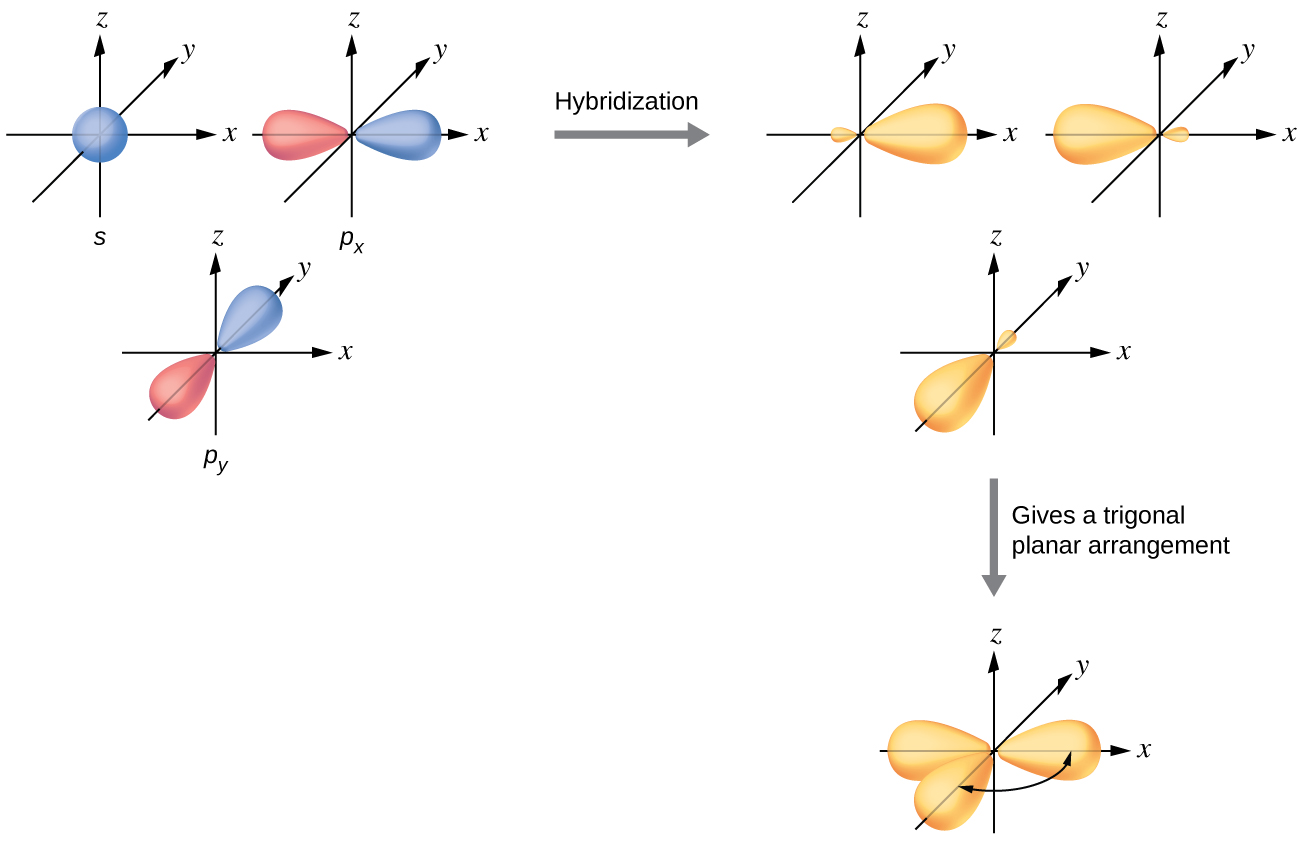
Although quantum mechanics yields the "plump" orbital lobes as depicted in Figure five, sometimes for clarity these orbitals are drawn thinner and without the small-scale lobes, as in Effigy 6, to avoid obscuring other features of a given illustration. We will use these "thinner" representations whenever the true view is too crowded to easily visualize.
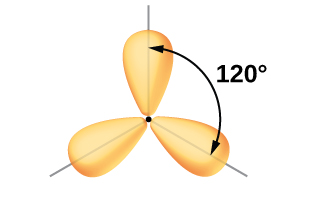
The observed structure of the borane molecule, BH3, suggests sp 2 hybridization for boron in this compound. The molecule is trigonal planar, and the boron cantlet is involved in three bonds to hydrogen atoms (Effigy vii). Nosotros can illustrate the comparison of orbitals and electron distribution in an isolated boron atom and in the bonded atom in BH3 equally shown in the orbital free energy level diagram in Figure 8. Nosotros redistribute the three valence electrons of the boron atom in the three sp 2 hybrid orbitals, and each boron electron pairs with a hydrogen electron when B–H bonds course.


Whatever central cantlet surrounded by iii regions of electron density will exhibit sp 2 hybridization. This includes molecules with a lonely pair on the central atom, such every bit ClNO (Figure 9), or molecules with two single bonds and a double bond continued to the central atom, as in formaldehyde, CH2O, and ethene, HiiCCHii.

sp 3 Hybridization
The valence orbitals of an atom surrounded by a tetrahedral arrangement of bonding pairs and solitary pairs consist of a set of four sp 3 hybrid orbitals. The hybrids result from the mixing of one s orbital and all three p orbitals that produces four identical sp 3 hybrid orbitals (Figure 10). Each of these hybrid orbitals points toward a different corner of a tetrahedron.
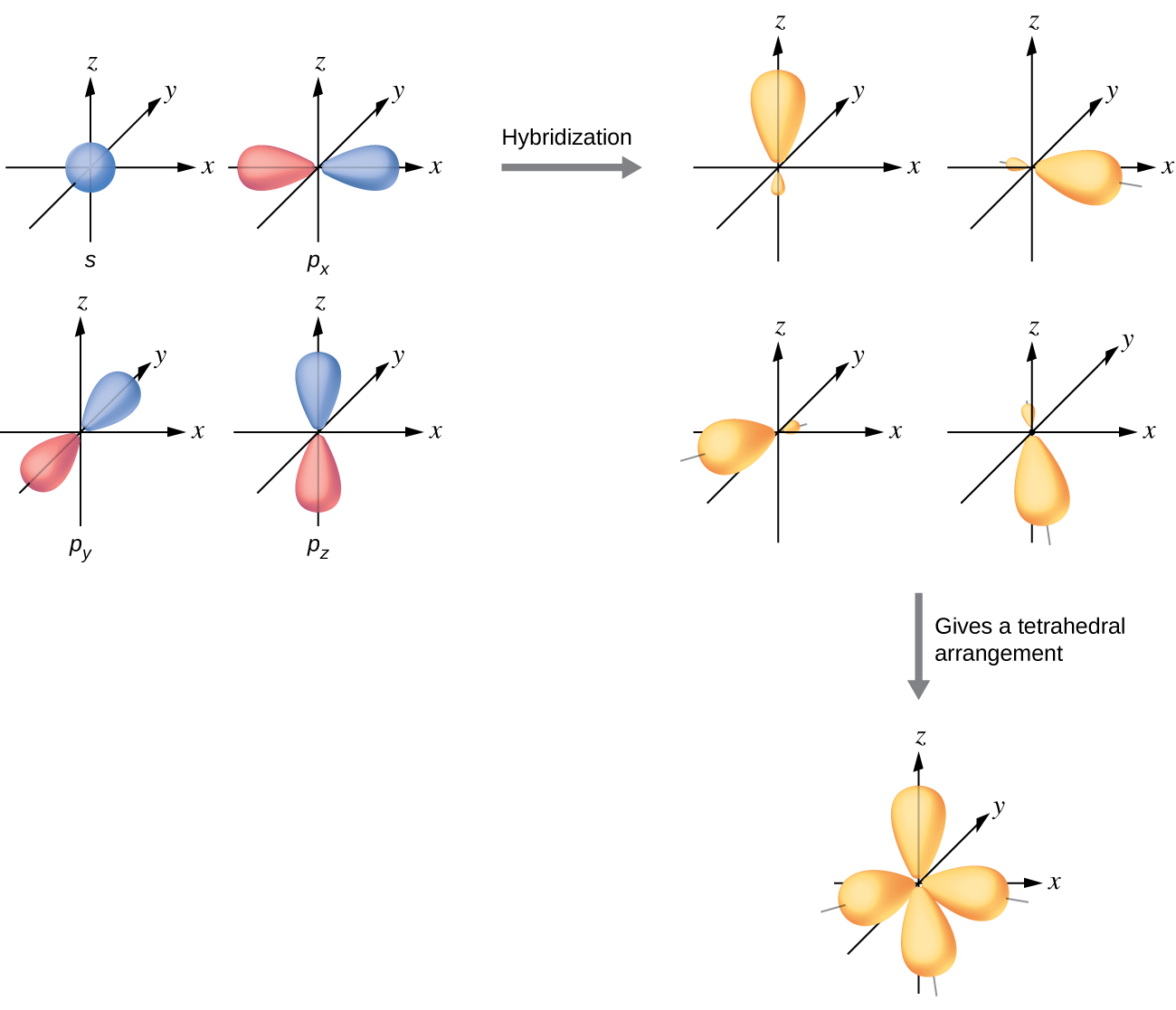
A molecule of methyl hydride, CHfour, consists of a carbon atom surrounded by four hydrogen atoms at the corners of a tetrahedron. The carbon cantlet in methane exhibits sp three hybridization. We illustrate the orbitals and electron distribution in an isolated carbon atom and in the bonded atom in CH4 in Effigy 11. The 4 valence electrons of the carbon cantlet are distributed equally in the hybrid orbitals, and each carbon electron pairs with a hydrogen electron when the C–H bonds course.

In a methane molecule, the ones orbital of each of the 4 hydrogen atoms overlaps with one of the iv sp 3 orbitals of the carbon atom to form a sigma (σ) bond. This results in the formation of iv strong, equivalent covalent bonds between the carbon atom and each of the hydrogen atoms to produce the marsh gas molecule, CHfour.
The construction of ethane, C2H6, is similar to that of methane in that each carbon in ethane has four neighboring atoms arranged at the corners of a tetrahedron—iii hydrogen atoms and ane carbon atom (Effigy 12). Yet, in ethane an sp 3 orbital of ane carbon cantlet overlaps stop to end with an sp 3 orbital of a second carbon cantlet to form a σ bond between the two carbon atoms. Each of the remaining sp 3 hybrid orbitals overlaps with an s orbital of a hydrogen cantlet to form carbon–hydrogen σ bonds. The structure and overall outline of the bonding orbitals of ethane are shown in Figure 12. The orientation of the two CH3 groups is not fixed relative to each other. Experimental evidence shows that rotation around σ bonds occurs hands.

An sp 3 hybrid orbital can also concord a lone pair of electrons. For instance, the nitrogen cantlet in ammonia is surrounded by three bonding pairs and a alone pair of electrons directed to the four corners of a tetrahedron. The nitrogen atom is sp 3 hybridized with one hybrid orbital occupied by the alone pair.
The molecular structure of water is consistent with a tetrahedral arrangement of two alone pairs and two bonding pairs of electrons. Thus we say that the oxygen cantlet is sp 3 hybridized, with two of the hybrid orbitals occupied by solitary pairs and two by bonding pairs. Since alone pairs occupy more than infinite than bonding pairs, structures that contain lone pairs have bond angles slightly distorted from the ideal. Perfect tetrahedra accept angles of 109.five°, but the observed angles in ammonia (107.3°) and water (104.5°) are slightly smaller. Other examples of sp 3 hybridization include CCl4, PCl3, and NCliii.
sp 3 d and sp iii d two Hybridization
To describe the 5 bonding orbitals in a trigonal bipyramidal organisation, we must use five of the valence shell diminutive orbitals (the s orbital, the 3 p orbitals, and one of the d orbitals), which gives five sp 3 d hybrid orbitals. With an octahedral organisation of half-dozen hybrid orbitals, we must use half-dozen valence beat atomic orbitals (the s orbital, the three p orbitals, and ii of the d orbitals in its valence shell), which gives six sp iii d 2 hybrid orbitals. These hybridizations are merely possible for atoms that take d orbitals in their valence subshells (that is, not those in the first or second period).
In a molecule of phosphorus pentachloride, PClfive, there are five P–Cl bonds (thus 5 pairs of valence electrons around the phosphorus atom) directed toward the corners of a trigonal bipyramid. Nosotros utilize the 3s orbital, the iii 3p orbitals, and one of the 3d orbitals to grade the set of five sp 3 d hybrid orbitals (Effigy 14) that are involved in the P–Cl bonds. Other atoms that exhibit sp 3 d hybridization include the sulfur cantlet in SFfour and the chlorine atoms in ClF3 and in ClF4 +. (The electrons on fluorine atoms are omitted for clarity.)

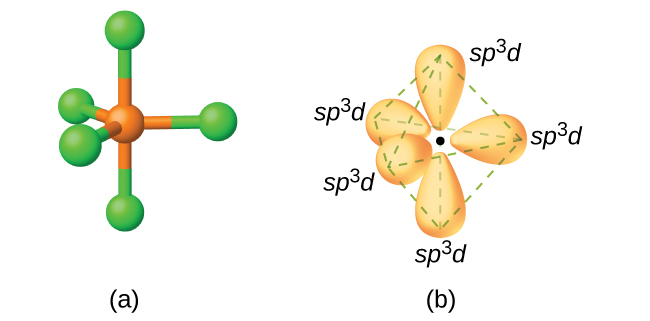
The sulfur atom in sulfur hexafluoride, SFhalf-dozen, exhibits sp 3 d 2 hybridization. A molecule of sulfur hexafluoride has half dozen bonding pairs of electrons connecting six fluorine atoms to a unmarried sulfur atom. There are no lone pairs of electrons on the central atom. To bond half dozen fluorine atoms, the 3south orbital, the three 3p orbitals, and two of the 3d orbitals form six equivalent sp 3 d 2 hybrid orbitals, each directed toward a different corner of an octahedron. Other atoms that showroom sp 3 d 2 hybridization include the phosphorus atom in PCl6 −, the iodine atom in the interhalogens IFhalf dozen +, IF5, ICl4 −, IFiv − and the xenon cantlet in XeF4.
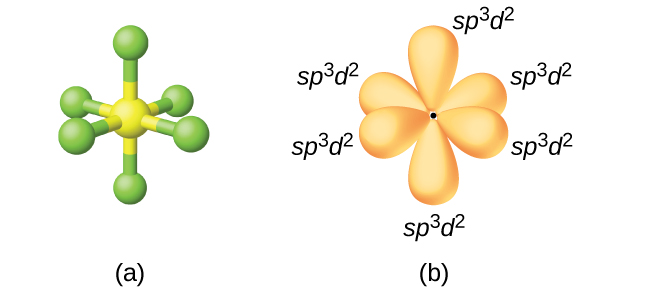
Assignment of Hybrid Orbitals to Primal Atoms
The hybridization of an atom is determined based on the number of regions of electron density that surround information technology. The geometrical arrangements characteristic of the various sets of hybrid orbitals are shown in Effigy 16. These arrangements are identical to those of the electron-pair geometries predicted past VSEPR theory. VSEPR theory predicts the shapes of molecules, and hybrid orbital theory provides an explanation for how those shapes are formed. To detect the hybridization of a cardinal cantlet, we can use the following guidelines:
- Determine the Lewis structure of the molecule.
- Determine the number of regions of electron density effectually an atom using VSEPR theory, in which single bonds, multiple bonds, radicals, and lone pairs each count as one region.
- Assign the gear up of hybridized orbitals from Figure 16 that corresponds to this geometry.
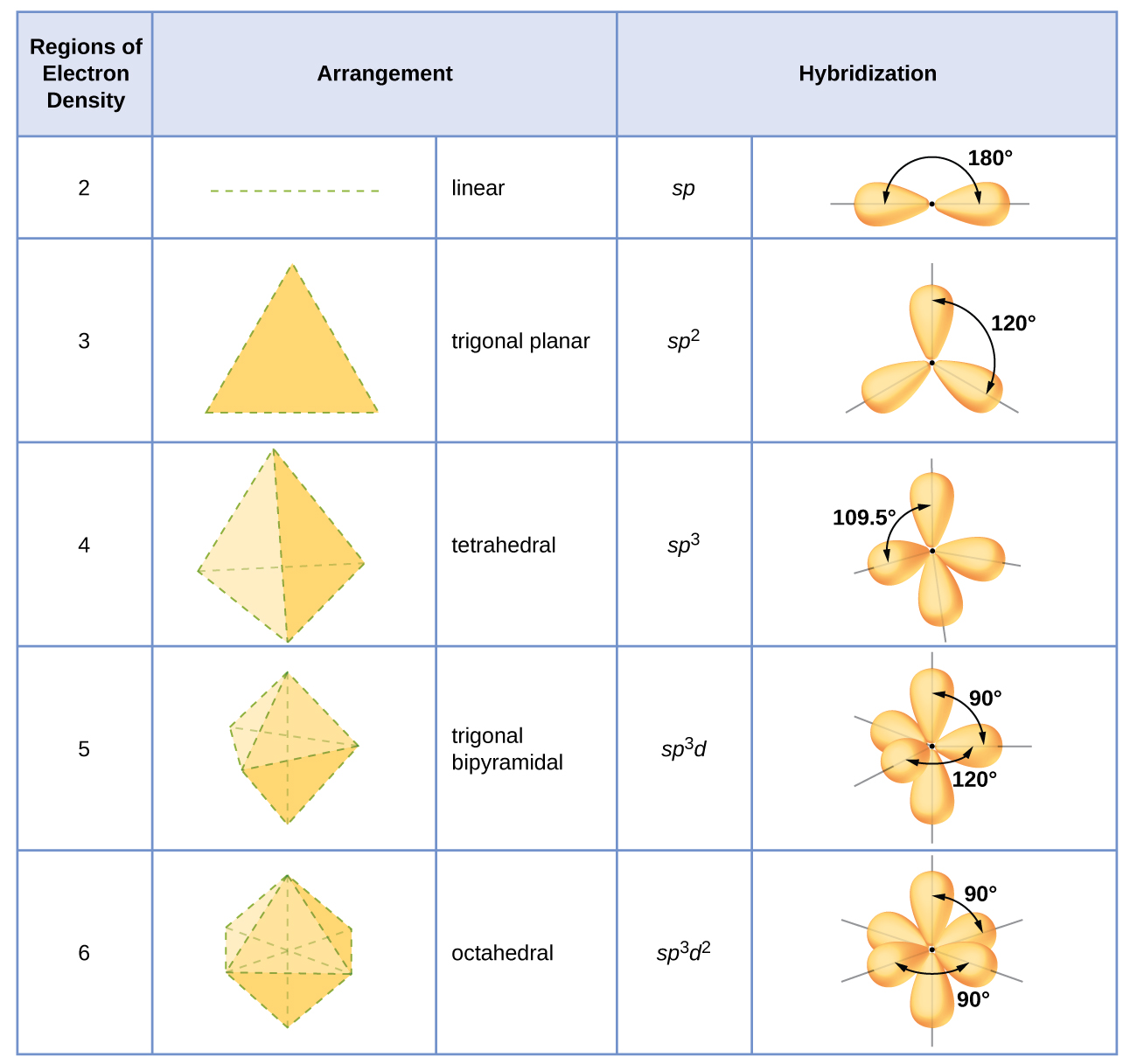
It is important to remember that hybridization was devised to rationalize experimentally observed molecular geometries. The model works well for molecules containing small central atoms, in which the valence electron pairs are close together in space. Withal, for larger fundamental atoms, the valence-shell electron pairs are farther from the nucleus, and there are fewer repulsions. Their compounds exhibit structures that are often not consistent with VSEPR theory, and hybridized orbitals are non necessary to explain the observed data. For instance, we take discussed the H–O–H bail bending in HtwoO, 104.5°, which is more consistent with sp 3 hybrid orbitals (109.5°) on the central atom than with iip orbitals (ninety°). Sulfur is in the same group equally oxygen, and HiiS has a similar Lewis structure. Withal, it has a much smaller bond angle (92.1°), which indicates much less hybridization on sulfur than oxygen. Continuing down the grouping, tellurium is even larger than sulfur, and for H2Te, the observed bond bending (ninety°) is consistent with overlap of the 5p orbitals, without invoking hybridization. We invoke hybridization where information technology is necessary to explain the observed structures.

Case i
Assigning Hybridization
Ammonium sulfate is of import as a fertilizer. What is the hybridization of the sulfur atom in the sulfate ion, SO4 2−?
Solution
The Lewis structure of sulfate shows there are four regions of electron density. The hybridization is sp 3.
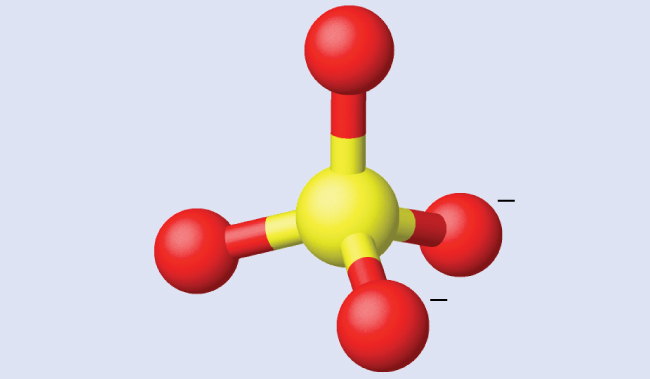
Check Your Learning
What is the hybridization of the selenium atom in SeF4?
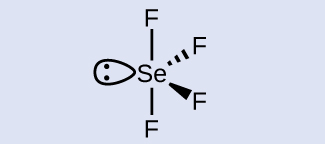
Answer:
The selenium atom is sp 3 d hybridized.
Example 2
Assigning Hybridization
Urea, NHiiC(O)NHii, is sometimes used every bit a source of nitrogen in fertilizers. What is the hybridization of each nitrogen and carbon atom in urea?
Solution
The Lewis structure of urea is
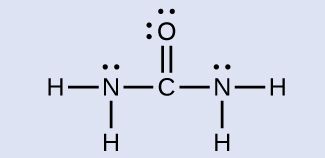
The nitrogen atoms are surrounded past four regions of electron density, which arrange themselves in a tetrahedral electron-pair geometry. The hybridization in a tetrahedral arrangement is sp three (Figure 16). This is the hybridization of the nitrogen atoms in urea.
The carbon atom is surrounded by three regions of electron density, positioned in a trigonal planar organization. The hybridization in a trigonal planar electron pair geometry is sp two (Figure xvi), which is the hybridization of the carbon atom in urea.
Bank check Your Learning
Acetic acid, H3CC(O)OH, is the molecule that gives vinegar its odor and sour gustatory modality. What is the hybridization of the ii carbon atoms in acetic acid?
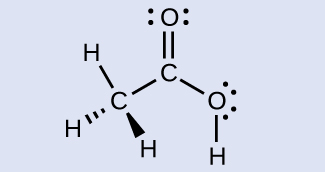
Answer:
H3 C, sp 3; C(O)OH, sp 2
Key Concepts and Summary
We can use hybrid orbitals, which are mathematical combinations of some or all of the valence atomic orbitals, to describe the electron density around covalently bonded atoms. These hybrid orbitals either form sigma (σ) bonds directed toward other atoms of the molecule or contain alone pairs of electrons. We can determine the type of hybridization around a fundamental atom from the geometry of the regions of electron density almost it. Two such regions imply sp hybridization; three, sp 2 hybridization; four, sp iii hybridization; 5, sp 3 d hybridization; and six, sp 3 d 2 hybridization. Pi (π) bonds are formed from unhybridized atomic orbitals (p or d orbitals).
Chemistry End of Chapter Exercises
- Why is the concept of hybridization required in valence bond theory?
- Give the shape that describes each hybrid orbital set:
(a) sp two
(b) sp iii d
(c) sp
(d) sp 3 d 2
- Explain why a carbon atom cannot form five bonds using sp 3 d hybrid orbitals.
- What is the hybridization of the central atom in each of the following?
(a) BeHii
(b) SF6
(c) PO4 three−
(d) PCl5
- A molecule with the formula ABthree could take one of four different shapes. Give the shape and the hybridization of the fundamental A atom for each.
- Methionine, CH3SCH2CHtwoCH(NH2)CO2H, is an amino acid found in proteins. Draw a Lewis construction of this chemical compound. What is the hybridization type of each carbon, oxygen, the nitrogen, and the sulfur?
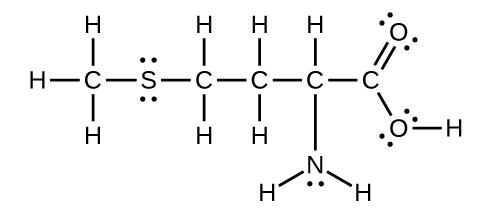
- Sulfuric acid is manufactured past a series of reactions represented by the post-obit equations:[latex]\text{Southward}_8(s) + 8 \text{O}_2(g) \longrightarrow 8\text{SO}_2(g)[/latex]
[latex]2\text{And then}_2(g) + \text{O}_2(g) \longrightarrow ii\text{SO}_3(one thousand)[/latex]
[latex]\text{Then}_3(g) + \text{H}_2 \text{O}(l) \longrightarrow \text{H}_2 \text{And then}_4(fifty)[/latex]Draw a Lewis construction, predict the molecular geometry by VSEPR, and determine the hybridization of sulfur for the following:
(a) circular S8 molecule
(b) Then2 molecule
(c) SO3 molecule
(d) H2Then4 molecule (the hydrogen atoms are bonded to oxygen atoms)
- Ii of import industrial chemicals, ethene, C2Hfour, and propene, CiiiHvi, are produced by the steam (or thermal) bang-up process:
[latex]two\text{C}_3 \text{H}_8(g) \longrightarrow \text{C}_2\text{H}_4(g) + \text{C}_3\text{H}_6(g) + \text{CH}_4(k) + \text{H}_2(1000)[/latex]
For each of the four carbon compounds, practise the following:
(a) Draw a Lewis structure.
(b) Predict the geometry about the carbon atom.
(c) Determine the hybridization of each type of carbon cantlet.
- For many years later they were discovered, information technology was believed that the noble gases could not form compounds. Now we know that belief to be incorrect. A mixture of xenon and fluorine gases, confined in a quartz bulb and placed on a windowsill, is plant to slowly produce a white solid. Analysis of the compound indicates that it contains 77.55% Xe and 22.45% F by mass.
(a) What is the formula of the compound?
(b) Write a Lewis structure for the compound.
(c) Predict the shape of the molecules of the compound.
(d) What hybridization is consistent with the shape y'all predicted?
- Consider nitrous acrid, HNO2 (HONO).
(a) Write a Lewis structure.
(b) What are the electron pair and molecular geometries of the internal oxygen and nitrogen atoms in the HNOii molecule?
(c) What is the hybridization on the internal oxygen and nitrogen atoms in HNO2?
- Strike-anywhere matches contain a layer of KClO3 and a layer of P4Southwardiii. The heat produced by the friction of striking the lucifer causes these two compounds to react vigorously, which sets fire to the wooden stem of the friction match. KClO3 contains the ClOthree − ion. P4Sthree is an unusual molecule with the skeletal structure.
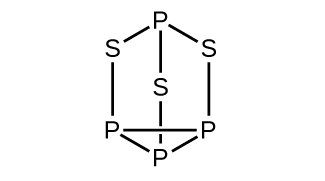
(a) Write Lewis structures for PivS3 and the ClO3 – ion.
(b) Describe the geometry about the P atoms, the S atom, and the Cl atom in these species.
(c) Assign a hybridization to the P atoms, the S atom, and the Cl cantlet in these species.
(d) Decide the oxidation states and formal charge of the atoms in P4Siii and the ClO3 – ion.
- Identify the hybridization of each carbon atom in the post-obit molecule. (The system of atoms is given; you demand to determine how many bonds connect each pair of atoms.)

- Write Lewis structures for NFiii and PF5. On the basis of hybrid orbitals, explain the fact that NF3, PF3, and PF5 are stable molecules, but NFv does non exist.
- In addition to NF3, ii other fluoro derivatives of nitrogen are known: N2F4 and Due north2Fii. What shapes do you predict for these two molecules? What is the hybridization for the nitrogen in each molecule?
Glossary
- hybrid orbital
- orbital created by combining atomic orbitals on a fundamental cantlet
- hybridization
- model that describes the changes in the atomic orbitals of an atom when information technology forms a covalent chemical compound
- sp hybrid orbital
- one of a prepare of two orbitals with a linear organisation that results from combining one due south and one p orbital
- sp 2 hybrid orbital
- one of a set of iii orbitals with a trigonal planar arrangement that results from combining one south and two p orbitals
- sp iii hybrid orbital
- one of a ready of four orbitals with a tetrahedral arrangement that results from combining one s and 3 p orbitals
- sp three d hybrid orbital
- one of a prepare of five orbitals with a trigonal bipyramidal arrangement that results from combining one s, three p, and one d orbital
- sp 3 d ii hybrid orbital
- one of a set of six orbitals with an octahedral system that results from combining 1 s, iii p, and two d orbitals
Solutions
Answers to Chemistry End of Affiliate Exercises
1. Hybridization is introduced to explain the geometry of bonding orbitals in valance bond theory.
3. At that place are no d orbitals in the valence beat out of carbon.
v. trigonal planar, sp 2; trigonal pyramidal (one lone pair on A) sp 3; T-shaped (two lone pairs on A sp 3 d, or (3 lone pairs on A) sp 3 d 2
7. (a) Each South has a aptitude (109°) geometry, sp three
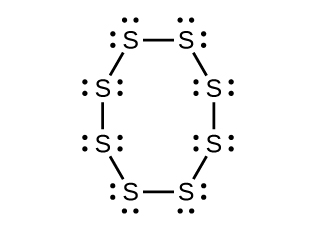
(b) Bent (120°), sp 2

(c) Trigonal planar, sp two
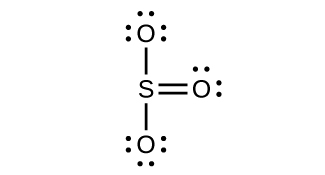
(d) Tetrahedral, sp 3
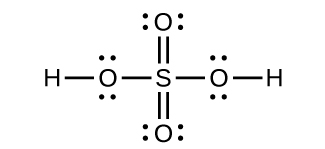
9. a) XeF2
(b)

(c) linear (d) sp 3 d
11. (a)

(b) P atoms, trigonal pyramidal; S atoms, aptitude, with 2 lone pairs; Cl atoms, trigonal pyramidal; (c) Hybridization about P, S, and Cl is, in all cases, sp iii; (d) Oxidation states P +1, [latex]\text{S} - 1\frac{1}{3}[/latex], Cl +5, O –2. Formal charges: P 0; S 0; Cl +2: O –1
13. 
Phosphorus and nitrogen can course sp 3 hybrids to form iii bonds and hold one alone pair in PF3 and NF3, respectively. All the same, nitrogen has no valence d orbitals, so it cannot form a set up of sp 3 d hybrid orbitals to bind v fluorine atoms in NFfive. Phosphorus has d orbitals and can bind five fluorine atoms with sp iii d hybrid orbitals in PFfive.
What Is The Name Of The Hybrid Orbitals Used By Phosphorus In Pcl3?,
Source: https://opentextbc.ca/chemistry/chapter/8-2-hybrid-atomic-orbitals/
Posted by: lightliess1983.blogspot.com


0 Response to "What Is The Name Of The Hybrid Orbitals Used By Phosphorus In Pcl3?"
Post a Comment